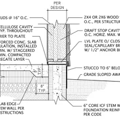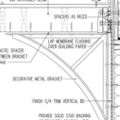I would like some information on sump systems from the 1960s or 1970s.
I have a house that was built in the late 1960s and in the basement I have a aprox. 3 foot round hole with a steel or catiron liner the is about 4 feet deep. This liner has several inlets coming into it that appear blocked. 2 are approx. 2″ in diamator ands on is 3/4” in diamitor. What I need to know is given the information above could this be a french drain type system and how would I know Also is there any way to figure out where the ppipes for such a system would run as the basement has a concrete floor?
We live in climate zone 5 on the map that was shown. Any help would be greatly appreciated.
Thanks Steve
GBA Detail Library
A collection of one thousand construction details organized by climate and house part










Replies
Septic system guys have a widget to track pipes underground give those guys a ring
Steve,
The drain pipe could come from almost anywhere; I don't think there is any way to generalize about such systems. Hopefully none of the pipes are discharging wastewater with a sewage smell (black water).
The most probable types of drain pipes connected to a sump are footing drains, interior French drains, and floor drains installed in the concrete slab of your basement. However, other types of drains may have been hooked up, including a washing-machine drain. You never know.
You can always try to snake out the drains from the sump. That can't hurt.